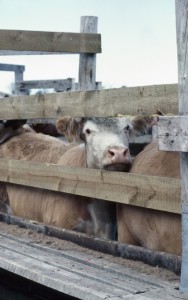
On this page, we highlight the following impacts of climate change on livestock production:
Click a link in the list above to jump to that topic on this page.
A changed climate will significantly impact agriculture in Manitoba.
Higher levels of carbon dioxide (CO2), changing rain patterns, higher temperatures and greater occurrence of extreme weather events will all modify livestock production in Manitoba.
Climate change is in the forecast. However, detailed predictions about how livestock production will be affected are unclear. Higher temperatures may increase heat stress for animals and the lack of precipitation will most likely limit access to good quality water. Changes to temperature and precipitation will most likely lower feed quality, adding to animal stress. The diseases and insect pests found in Manitoba may also change, negatively affecting animals.1 Generally, climate change models predict an uncertain future for agriculture in Manitoba, with potential benefits most likely being offset by major drawbacks.2
The following sections will help clarify the potential benefits and drawbacks of climate change on livestock production in Manitoba.
Heat Stress
As seasonal temperatures rise with the changing climate, livestock will be more vulnerable to heat stress during the warmest months.3 Animals tend to eat less when under heat stress, resulting in less weight gain and decreased performance and reproduction.4 Heat stress models have predicted that by 2040 in the central US, swine may take 1.5 to 3.7 days longer to reach slaughter weight. In cattle, it could take 2.8 to 4.8 days longer, and milk production could be reduced up to 2.9 percent.5 Hogs and poultry are especially susceptible to heat stress because they have no sweat glands. Increased demand for water and barn cooling systems may result.6 Stressed animals also have a weaker immune system, making them more susceptible to diseases.7
However, because winters are predicted be less extreme, over-wintering cattle will probably face a less harsh environment, and will most likely gain more weight over the winter.8 In an effort to maintain optimum levels of animal production, climate change may result in some livestock producers selecting breeds that are genetically adapted to the current climatic conditions.9
Insects and disease
The exact impacts of climate change on insects and pathogens are somewhat uncertain; some changes may be favourable, while others may be negative.
Warmer, longer growing seasons will most likely increase insect life cycles with the early onset of spring.10 Climate change may also increase the transfer potential of diseases and infections between animals and possibly humans.11 Almost certainly, climate change will enhance insect development rates, create new diseases, and alter animal husbandry techniques. Changes to livestock feeding and rearing practices will be necessary. The increased use of medication on sick animals may potentially lead to more chemicals in food.12
Animal husbandry
Climate-induced changes will influence how livestock are reared. Certain species or breeds of animals may need to spend more time inside to avoid heat exposure. A similar situation may occur if there is limited access to adequate amounts of water. Confined spaces and overcrowding indoors could lead to faster disease transmission. The overcrowding of livestock at watering sources could result in animal stress, greater pathogen output in one area of the paddock and reduced water quality.13 It will become increasingly important to ensure livestock have sufficient access to shade, to minimize pen overcrowding, and to provide indoor ventilation to limit heat stress.14
Water resources
Although overall growing season precipitation on the Prairies is expected to decrease, precipitation is anticipated to occur in intense events.15 Warmer temperatures combined with longer dry spells between rain events will likely increase drought severity and frequency.16 Water-stressed areas will expand to include drier areas of the province where seasonal lack of water is already a concern.17
Lack of water will place increased demands on available water resources affecting water quality and quantity on a seasonal basis.18 Mild winters and limited snowfall may decrease water availability. Water stress may lower water basin and lake levels, decreasing water quality with the possibility of increasing toxin and pathogen concentrations in water supplies.19 Algal blooms may also become a problem affecting water quality.20 Water storage systems will become important for access to clean drinking sources.
 For more information, download our publication “Farming in a Changing Climate in Manitoba – Livestock Edition (2013)“
For more information, download our publication “Farming in a Changing Climate in Manitoba – Livestock Edition (2013)“




